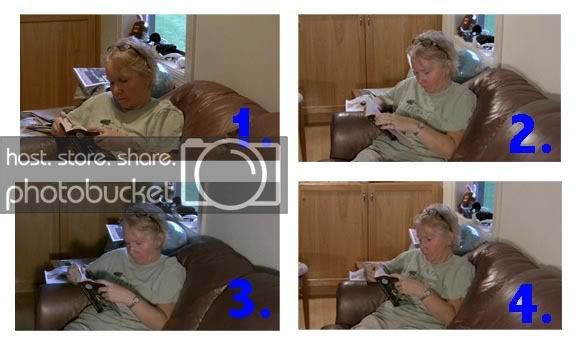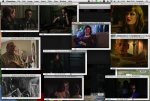Nice attempts and it's always a good idea to play around with your lighting set-ups for your desired outcome. I like 1 most because it looks more natural and most importantly the lighting does not bring attention to itself which is key (no pun intended) to good lighting.
Consider this, in a three point lighting set-up your key (source) light is the strongest light in the setup and is motivated by something - in this case, without being privy to the whole scene, I would say it's the window behind her. So that is the motivation for the key light placement. Your fill (which could be a light or a bounce card) will be on the other side of the key and it's job is to fill some of the shadows created by the key - some of the hard shadows that are naturally caused in eye-sockets, the other side of the nose, throat, etc.) Then you have your rim or back light that helps separate the subject/object from the background - to define/create depth in the frame.
So that's why I like 1 because...
a) the key seems to be the right place and does not bring attention to itself.
b) The fill seems a tad bit forced but like I said I cannot see the whole scene so maybe there is a practical (lamp, small window or some other light source) that motivates the use of an actual light as as fill, otherwise, a simple bounce card would have done the same thing without calling attention to itself. Which brings us to...
c) The rim light. This is a tricky one for a few reasons. First, the angle of the shot and the fact that the subject is already sitting with her back almost directly towards the strong light source (the window) do you really need another light for separation? I am not judging just asking the questions you should be asking yourself when you set up the scene. Also, this is the part many get wrong in lighting - be very careful when back lighting blonds or people with white and silver hair. Their hair is already bright and adding light to that could cause exposure problems (especially on close ups). So like Aegis said, in the cases where you need to create separation between a subject with blond/silver/gray hair you could bounce light off of the background or something. While on this topic, when rim lighting a bald subject you may want to do some tricks like spray an aerosol deodorant or something to take a bit off the shine from the top (to deal with the potential exposure problems). Finally, broaden your creative considerations and start thinking about set design. I like the general angle of the shot and I know it's a test but you could do more with the composition. But nothing pops for me in these shots because of the overpowering Earth tones all over the place. Everything is in some shade of brown which is drowning you subject. There are more considerations to lighting a scene and what you are lighting should be one of them.
You could have lit this scene with only one light and perhaps a bounce card. That's why when people start talking about three point lighting it's most important to understand that it's a matter of concept more so than actually having three physical lights.
I also need to address one more tid-bit, you used the word "cinematic" and I am not sure where you were going with that. If you were in fact looking for a dramatic look then you would be talking about a lo-key type setting where you're source (key) light would be more pronounced thereby creating contrasting shadows (how deep is based on the look you are going for or what your story demands) on the fill side. Or your could be going for no contrast (affinity) at all and the scene is either evenly or close to being evenly lit (with little to no shadows) - a technique employed in comedies. Either way both looks can be considered as "cinematic".
To wrap things up, try picking up a copy of "Placing Shadows, Lighting Techniques for Video Production" Third Edition by Chuck Gloman and Tom Letourneau. It was a great primer for me from a lighting POV.
Nice effort. Keep up the good work.





